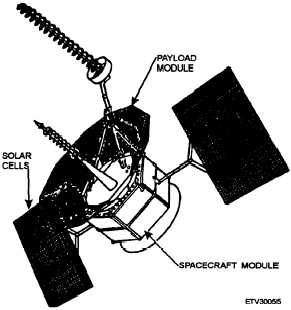SATELLITES
In 1976, three satellites were placed into orbit over
the Atlantic, Pacific, and Indian Oceans. These
satellites, called MARISATs, were procured by and
are managed by the COMSAT General Corporation.
Each satellite has three uhf channels for military use
(one wideband 500-kHz channel and two narrowband
25-kHz channels). The uhf section of each satellite is
leased to the Navy for communications. To distinguish
the special management and control functions for
communications on these uhf channels, the Navy has
given the leased MARISAT satellite assets the name
GAPFILLER.
Current planning calls for no Navy use of
GAPFILLER satellites after the mid-1990’s. Satellite
coverage will then be provided by a combination of
F L T S A T and L E A S A T until the new U H F
FOLLOW-ON (UFO) satellites are placed into
service. The Navy plans to have two operational
satellites in each of four satellite coverage areas. Each
satellite coverage area can be terminated in at least two
NCTAMS, allowing around-the-world connectivity.
You can see this connectivity in figure 3-16.
FLTSATCOM SATELLITE
The FLTSATCOM satellite consists of two major
parts: a payload module that includes the antennas and
a space craft module with a solar array. The payload
module contains the uhf, shf, and S-band (tracking,
telemetry, and command) communications equipment
antennas. The communications equipment is mounted
internally on side panels that cover this section of the
satellite.
The space craft module contains nearly all other
subsystem equipment, including sensors, attitude and
velocity control, telemetry, tracking and command,
and electrical power distribution. The spacecraft is
stabilized on three axes, and the body-fixed antennas
are kept pointing at the sun by a clock drive. A
FLTSATCOM satellite is shown in figure 3-17.
E a c h F L T S A T C O M s a t e l l i t e c a n r e l ay
communications on 23 separate uhf channels. Of the
23 channels, 10 are 25-kHz channels, 12 are 5-kHz
channels, and one is a 500-kHz channel. The ten 25-
kHz channels are dedicated for Navy use. Each 25-kHz
uhf down-link channel has a separate transmitter.
Channel one, used in primary mode for Fleet Broadcast
transmissions, incorporates signal processing within
the satellite (the shf up-link signal is translated to uhf
Figure 3-17.—FLTSATCOM satellite.
for down-link transmission). In addition, two of the
FLTSATCOM satellites have ehf packages attached.
FLTSAT Extremely-High-Frequency Package
(FEP)
The Fleet Satellite (FLTSAT) Extremely-High-
Frequency (EHF) Package (FEP) provides ehf
communications capability for Army, Navy, and Air
Force ground, airborne, and ocean-going terminals.
Two FEPs are currently in orbit, carried aboard two
modified uhf FLTSATs, numbers seven and eight.
FEP operates at ehf frequencies of approximately
20-GHz on the down-link and 44-GHz on the up-link.
It has two antenna beams: (1) a dual-frequency spot
beam steerable by ground command, and (2) an earth
coverage beam that uses separate horn antennas for
transmit and receive.
LEASAT SATELLITE
The LEASAT satellite has seven 25-kHz uhf
down-link channels, one 500-kHz wide-band channel,
and five 5-kHz channels. One of the seven 25-kHz
down-link channels is used for Fleet Broadcast.
The broadcast up-link is shf, with translation to
uhf taking place in the satellite. The remaining
3-21

